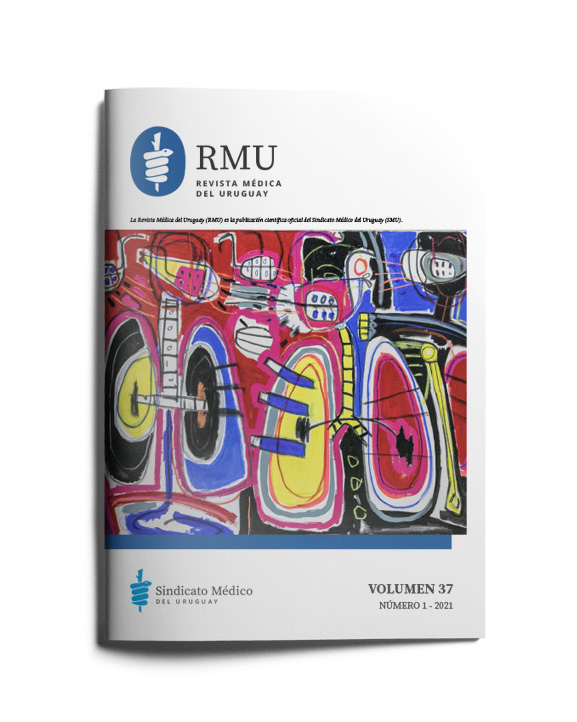Arbovirus in Uruguay, a potential problem
Review from a perinatal perspective
Abstract
Arbovirus are microorganisms transmitted to humans through arthropods. There are more than 100 different arboviruses with a common clinical presentation of fever, articular, hemorrhagic and neurological symptoms. They represent a mayor risk to pregnant women and fetuses due to their teratogenic effect, particularly affecting the central nervous system. We performed a specific search focused on arbovirus using search engines Pubmed and Google Scholar and we classified evidence according to the risk of a certain virus entering our country and its potential consequences. The objective of this review is to update the main clinical characteristics of arbovirus, particularly Dengue, Zika, Chikungunya and Yellow Fever particularly due to the potential introduction of these viruses in our country and the possibility of vertical transmission, so that our human resources have a guide on how to approach these patients nowadays. This review allowed us to conclude on common characteristics of these viruses, their possible consequences on fetus and newborns, and concluding on the difficulty of etiological diagnosis due to cross reactions.
References
(2) Uruguay. Ministerio de Salud Pública. Guía clínica de atención de pacientes con dengue. Montevideo: MSP, 2011. Disponible en: https://www.gub.uy/ministerio-salud-publica/sites/ministerio-salud-publica/files/documentos/publicaciones/Gu%C3%ADa%20cl%C3%ADnica%20de%20atenci%C3%B3n%20de%20pacientes%20con%20Dengue_1.pdf. (Consulta: 15 abril 2020).
(3) Uruguay. Presidencia. Gobierno desplegó medidas para contener situación ante aparición de un caso de dengue autóctono en Salto. Montevideo, 6 de marzo de 2020. Disponible en: https://www.presidencia.gub.uy/comunicacion/comunicacionnoticias/salud-dengue-caso-autoctono-salinas-ministro-msp-vigilancia-epidemiologica. (Consulta: 15 abril 2020).
(4) Uruguay. Ministerio de Salud Pública. Dirección General de Salud. División Epidemiología. Brote de dengue en Uruguay. Bol Epidemiol 2016; 2:21-9. Disponible en: https://www.gub.uy/ministerio-salud-publica/comunicacion/publicaciones/boletin-epidemiologico-noviembre-2016. (Consulta: 15 abril 2020).
(5) Vouga M, Chiu Y, Pomar L, de Meyer S, Masmejan S, Genton B, et al. Dengue, Zika and chikungunya during pregnancy: pre- and post-travel advice and clinical management. J Travel Med 2019; 26(8):taz077. doi: 10.1093/jtm/taz077.
(6) Marinho P, Cunha A, Amim Junior J, Prata-Barbosa A. A review of selected Arboviruses during pregnancy. Matern Health Neonatol Perinatol 2017; 3:17. doi: 10.1186/s40748-017-0054-0.
(7) Liu L, Dehning M, Phipps A, Swienton R, Harris C, Klein K. Clinical update on dengue, chikungunya, and zika: what we know at the time of article submission. Disaster Med Public Health Prep 2017; 11(3):290-9. doi: 10.1017/dmp.2016.144.
(8) Romero-Santacruz E, Lira-Canul J, Pacheco-Tugores F, Palma-Chan A. Dengue neonatal: presentación de casos clínicos. Ginecol Obstet Mex 2015; 83(5):308–15.
(9) Ribeiro C, Lopes V, Brasil P, Pires A, Rohloff R, Nogueira R. Dengue infection in pregnancy and its impact on the placenta. Int J Infect Dis 2017; 55:109-12. doi: 10.1016/j.ijid.2017.01.002.
(10) Xiong Y, Mo Y, Shi T, Zhu L, Chen Q. Dengue virus infection during pregnancy increased the risk of adverse fetal outcomes? An updated meta-analysis. J Clin Virol 2017; 94:42-9. doi: 10.1016/j.jcv.2017.07.008.
(11) Moraes M, Mayans E, Sobrero H, Borbonet D. Dengue en el recién nacido. Arch Pediatr Urug 2016; 87(3):269-71.
(12) Gregianini T, Ranieri T, Favreto C, Nunes Z, Tumioto Giannini G, Sanberg N, et al. Emerging arboviruses in Rio Grande do Sul, Brazil: Chikungunya and Zika outbreaks, 2014-2016. Rev Med Virol 2017; 27(6):e1943. doi: 10.1002/rmv.1943.
(13) Calle J, López-Medina E. Zika Virus. En: Cantey J, ed. Neonatal infections: pathophysiology, diagnosis, and management. New York: Springer, 2018:207-15.
(14) Moraes M, Sobrero H, Mayans E, Borbonet D. Infección por virus Zika en el embarazo y recién nacido. Arch Pediatr Urug 2016; 87(4):374-83.
(15) Wikan N, Smith D. Zika virus: history of a newly emerging arbovirus. Lancet Infect Dis 2016; 16(7):e119-26. doi: 10.1016/S1473-3099(16)30010-X.
(16) Kim K, Shresta S. Neuroteratogenic Viruses and Lessons for Zika Virus Models. Trends Microbiol 2016; 24(8):622-36. doi: 10.1016/j.tim.2016.06.002.
(17) Mann T, Haddad L, Williams T, Hills S, Read J, Dee D, et al. Breast milk transmission of flaviviruses in the context of Zika virus: a systematic review. Paediatr Perinat Epidemiol 2018; 32(4):358-68. doi: 10.1111/ppe.12478.
(18) Contopoulos-Ioannidis D, Newman-Lindsay S, Chow C, LaBeaud A. Mother-to-child transmission of Chikungunya virus: a systematic review and meta-analysis. PLoS Negl Trop Dis 2018; 12(6):e0006510. doi: 10.1371/journal.pntd.0006510.
(19) Torres J, Falleiros-Arlant L, Dueñas L, Pleitez-Navarrete J, Salgado D, Castillo J. Congenital and perinatal complications of chikungunya fever: a Latin American experience. Int J Infect Dis 2016; 51:85-8. doi: 10.1016/j.ijid.2016.09.009.
(20) Salvatella Agrelo R. Aedes aegypti, Aedes albopictus (Diptera, Culicidae) y su papel como vectores en las Américas: la situación de Uruguay. Rev Méd Urug 1996; 12(1):28-36.
(21) Organización Panamericana de la Salud. Actualización epidemiológica: fiebre amarilla. Washington, DC: OPS, 2019.
(22) Diniz L, Romanelli R, de Carvalho A, Teixeira D, de Carvalho L, Ferreira Cury V, et al. Perinatal yellow fever: a case report. Pediatr Infect Dis J 2019; 38(3):300-1.
(23) Maguiñas-Vargas C. Fiebre amarilla y gestación. Rev Per Ginecol Obstet 2010; 56(3):179–82.

This work is licensed under a Creative Commons Attribution-NonCommercial 4.0 International License.













